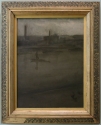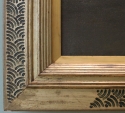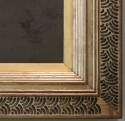The Paintings of James McNeill Whistler
YMSM 121
Grey and Silver: The Thames

Date
Grey and Silver: The Thames is extremely difficult to date. Originally considered to date from the early 1870s, it has (with some reservations!) been redated to the later 1890s.
1872: It is, as a subject, related to Whistler's early 1870s Nocturnes. It was dated 'about 1870/5' in the 1980 catalogue raisonné. 1 The frame dates from the 1870s but does not help in the dating of the nocturne since it was not made for this picture.
1885: Whistler was also 'painting at night for night effects' in 1885 as Alan Summerly Cole (1846-1934) noted in his diary on 26 November. 2 Thus, a date in the mid-1880s could be possible, but the technique does not seem appropriate for that period.

Grey and Silver: The Thames, The Hunterian
1887: Grey and Silver: The Thames is a view of the Thames like that seen from what is now the Savoy Hotel, with Charing Cross Railway Bridge barely visible on the right. Since the Hotel was built in 1887, this might suggest a later date for the picture.

The Thames, lithotint (C161), Freer Gallery of Art F1902.141
1896: The close resemblance of the view to that seen in Whistler's later nocturne, the lithotint, The Thames c161, done from the Savoy Hotel in 1896, suggests that Whistler was returning to earlier subjects at this very late date.
Grey and Silver: The Thames is very close in size to La Sylphide y494, which has been dated between 1896 and 1900. Furthermore, the unlined, fine plain open weave canvas is of the same type as the unlined canvas for Study of an Italian Boy y514, which is recorded as dating from between 1897 and 1900. 3
This adds substance to the suggestion that Grey and Silver: The Thames could date from as late as 1896, and would in that case be Whistler's last oil Nocturne.
Images

Grey and Silver: The Thames, The Hunterian

Grey and Silver: The Thames, The Hunterian

Grey and Silver: The Thames, frame detail

Grey and Silver: The Thames, frame detail

The Thames, lithotint (C161), Freer Gallery of Art F1902.141
Subject
Titles
Whistler's original title is not known. The accepted title varies only in punctuation:
- 'Grey and Silver – The Thames' (1904, Royal Scottish Academy). 4
- 'Grey and Silver: The Thames' (1915, Colnaghi). 5
- 'Grey and Silver: The Thames' (1980, YMSM). 6
'Grey and Silver: The Thames' is the preferred title, in conformity with other titles.
Description

Grey and Silver: The Thames, The Hunterian
A river scene in vertical format. In the foreground is a road along the riverside, and on the far bank, factories, factory chimneys and warehouses. On the river, to left, is a sailing barge.
Site
Grey and Silver: The Thames is a view of the Thames from what is now the Savoy Hotel, with Charing Cross Railway Bridge (built in 1864) barely visible on the right.
The tall chimney seen across the river is the Shot Tower at the Lambeth Lead Works, which stood on the South Bank of the River Thames, between Waterloo Bridge and Hungerford Bridge. It was a prominent landmark and favoured subject for artists, including Joseph Mallard William Turner (1775-1851). It was designed by David Riddal Roper and built for Thomas Maltby & Co. in 1826. It was demolished to make way for the Queen Elizabeth Hall, which opened in 1967.

The Thames, lithotint (C161), Freer Gallery of Art F1902.141
In 1896 Whistler made a lithotint, The Thames, the last of his printed Nocturnes, of the same view. The lithotint is very close in composition to Grey and Silver: The Thames, even to the inclusion, in wash, of several barges sailing downstream like the loosely painted barges in the oil painting, and the diagonal line of the embankment in the foreground. 7
Technique
Composition

The Thames, lithotint (C161), Freer Gallery of Art F1902.141

Grey and Silver: The Thames, The Hunterian
It has been suggested that Whistler referred to this oil when working on his 1896 lithotint The Thames c161'. 8 This is not proven, but the relationship between these two is very close indeed, leading to a rethinking about the date of the oil itself.
Technique

Grey and Silver: The Thames, The Hunterian
Grey and Silver: The Thames was painted on a linen canvas, probably French, which has a very coarse open plain weave (11 and 13 threads/cm) and heavy glue size. 9
It has a distinctive placement of tacks on the tacking margins, with more tacks near the corners, and was primed after stretching. The thin grey priming that is present is probably Whistler’s, since it was applied only to the stretched canvas. It consists of lead white with significant amounts of chalk, and presumed bone black, in oil. The fibres are linen, and its dark and degraded state is an effect of oil-rich and medium-rich paint soaking into it. 10
It is an exceptionally cool, grey monochrome study. The buildings across the river are painted thinly and softly; the outlines are imprecise and merge into each other. The large chimney was tried out several times further to the right. The sky, with the brushstrokes going in every direction, was painted slightly more thickly. The paint on the river itself, and the barges on it, is nearly as thin as watercolour. Professor Townsend noted:
'The paint is very thin except where Whistler reworked the heavily clouded sky, down to the existing skyline. All of the original paint was thinned a lot; it includes only a little lead white and a lot of bone black, and was applied with a long soft brush that left many hairs in the paint. The reworked paint is unusually thick, also includes lead white and bone black, and was pastier than Whistler’s usual paint, which has made it trap air bubbles.' 11
Conservation History
It is unlined, with some areas of weakness and of strain on the canvas resulting in cusping. However, the paint and support are in sound condition. 12 The varnish is yellowed, giving the picture its current yellow/brown appearance. 13
Frame
ca 1878: partial Flat Whistler, painted seigaiha (waves) pattern.

Grey and Silver: The Thames, The Hunterian

Grey and Silver: The Thames, frame detail

Grey and Silver: The Thames, frame detail
This is not the original frame for this painting; it appears to have been constructed from left-over moulding or cut down pieces from another frame, at some date unknown. The reeded outer frame is missing, the seigaiha pattern is thick and mottled and does not run consistently around the image. The blank space, probably intended for a butterfly signature, is at lower left, but Whistler usually signed his frames at the side.
History
Provenance
- 1903: in Whistler's studio at his death, and bequeathed to his ward and executrix, Rosalind Birnie Philip (1873-1958);
- 1935: given by Miss R. Birnie Philip to the University of Glasgow.
Exhibitions
It was not exhibited in Whistler's lifetime.
It was lent by Miss Birnie Philip, during the First World War, to an exhibition at Colnaghi's in London, where it received good reviews. The Glasgow Herald considered it 'a particularly expressive nocturne' and the Times critic wrote, 'no one could imitate that. There is … the poet who did succeed now and again among many failures, and when he succeeds we forget the failures'. 14
By the terms of Miss Birnie Philip's gift to the University of Glasgow, it cannot now be lent to another venue.
Bibliography
Catalogues Raisonnés
- Young, Andrew McLaren, Margaret F. MacDonald, Robin Spencer, and Hamish Miles, The Paintings of James McNeill Whistler, New Haven and London, 1980 (cat. no. 121), plate 80, as 'Grey and Silver: The Thames'.
Authored by Whistler
- None.
Catalogues 1855-1905
- 78th Exhibition of the Royal Scottish Academy of Painting, Sculpture and Architecture, Royal Scottish Academy, Edinburgh, 1904 (cat. no. 322) as 'Grey and Silver – The Thames'.
Journals 1855-1905
- None.
Monographs
- None.
Books on Whistler
- None.
Books, General
- McLaughlan, Robert, Gifted, Edinburgh, 1990, pp. 110-11, repr.
Catalogues 1906-Present
COLLECTION:
- Hopkinson, Martin J., James McNeill Whistler at the Hunterian Art Gallery, University of Glasgow, Glasgow, 1990, p. 44.
- Allan, Christopher J., A Guidebook to the Hunterian Art Gallery of the University of Glasgow, Glasgow, Hunterian Art Gallery, University of Glasgow, 1991, p. 15, repr.
EXHIBITION:
- Loan Exhibition of Works by James McNeill Whistler to aid the Professional Classes War Relief Council, Messrs Colnaghi, London, 1915 (cat. no. 6) as 'Grey and Silver: The Thames'.
- James McNeill Whistler, University of Glasgow, Glasgow, 1936 (cat. no. 39).
- Young, A. McLaren, Glasgow University's Pictures, Colnaghi, London, 1973 (cat. no. 75, ref.) (not exhibited).
- Hopkinson, Martin, From Apprentice to Master: Whistler's Graphic Art, Hunterian Art Gallery, University of Glasgow, Glasgow, 1992 (cat. no. 55).
- ホイスラー展. Whistler Exhibition in Japan, Isetan Museum of Art, Tokyo; Hokkaido Museum of Modern Art, Sapporo; Shizuoka Prefectural Museum, Shizuoka, 1986, (cat. no. 113, ref.) p. 204 (not exhibited).
- McNamara, Carol, and John Siewert, Whistler: Prosaic Views, Poetic Vision, exhibition catalogue, University of Michigan, Ann Arbor, 1996, p. 177, repr. fig. 77a (not exhibited).
Journals 1906-Present
- Getscher, Robert H., 'Whistler's ways with water', in Cheney, Liana DeGirolami, and Paul G. Marks, The Whistler Papers, Whistler House Museum, Lowell, MA, 1986, p. 38.
- Stoner, Joyce Hill, 'Whistler's views on the restoration and display of his paintings', Studies in Conservation, vol. 42, issue 2, 1997, pp. 107-14, at p. 111.
Newspapers 1906-Present
- Anon., 'Unexpected Whistlers', The Glasgow Herald, Glasgow, 1 June 1915.
- Anon., 'A Whistler Exhibition', The Times, London, 1 June 1915.
- Anon., 'Art and Artists', The Observer, London, 6 June 1915.
Websites
- Hunterian website at http://collections.gla.ac.uk/#/details/ecatalogue/41101.
- Art UK website at https://artuk.org.
Unpublished
- None.
Other
- None.
Notes:
1: YMSM 1980 [more] (cat. no. 121).
2: Ms Copy, GUW #03432.
3: Prof. Joyce H. Townsend, Tate Britain, technical and visual examination and report, June 2017.
4: 78th Exhibition of the Royal Scottish Academy of Painting, Sculpture and Architecture, Royal Scottish Academy, Edinburgh, 1904 (cat. no. 322).
5: Loan Exhibition of Works by James McNeill Whistler to aid the Professional Classes War Relief Council, Messrs Colnaghi, London, 1915 (cat. no. 6).
6: YMSM 1980 [more] (cat. no. 121).
7: Spink 1998 [more] (cat. no. 161).
8: The Hunterian website at http://www.huntsearch.gla.ac.uk (accessed 2016).
9: Prof. Joyce H. Townsend, Tate Britain, notes that C. W. Esckersberg used a comparable canvas in 1845, and this was likely a French canvas: examination report, June 2017. See Filtenborg, Troels, and Cecil Krarup Andersen, 'Canvas supports and grounds in paintings by C. W. Eckersberg', in Townsend, J. H., and A. Vandivere (eds), Studying the European Visual Arts 1800-1850: Paintings, Sculpture, Interiors and Art on Paper, London, 2017.
10: Technical analysis at Natural History Museum, London, for Townsend, 2017, op. cit.
11: Townsend 2017, op. cit.
12: Clare Meredith, condition report, 14 May 2001, Hunterian files.
13: Townsend 2017, op. cit.
14: Anon., 'Unexpected Whistlers', The Glasgow Herald, Glasgow, 1 June 1915; Anon., 'A Whistler Exhibition', The Times, London, 1 June 1915.